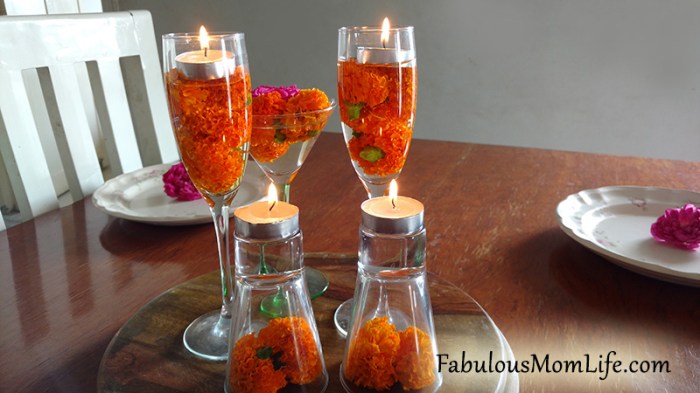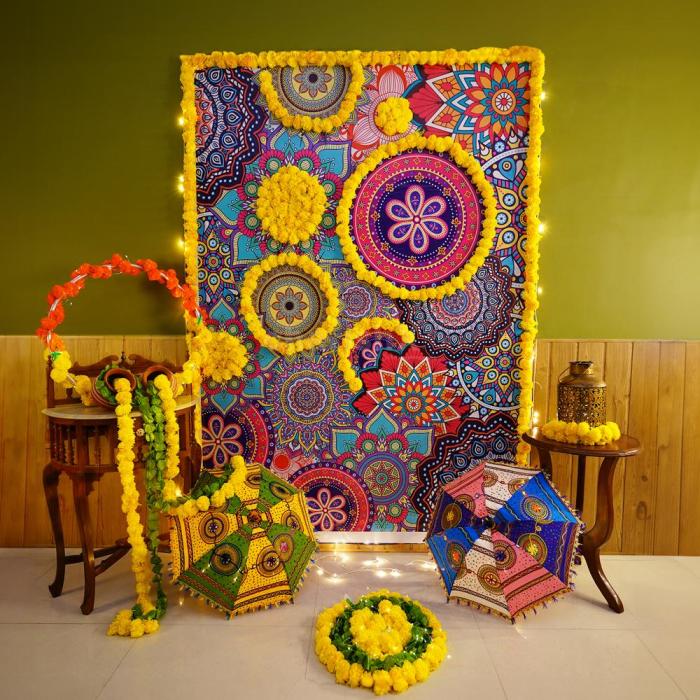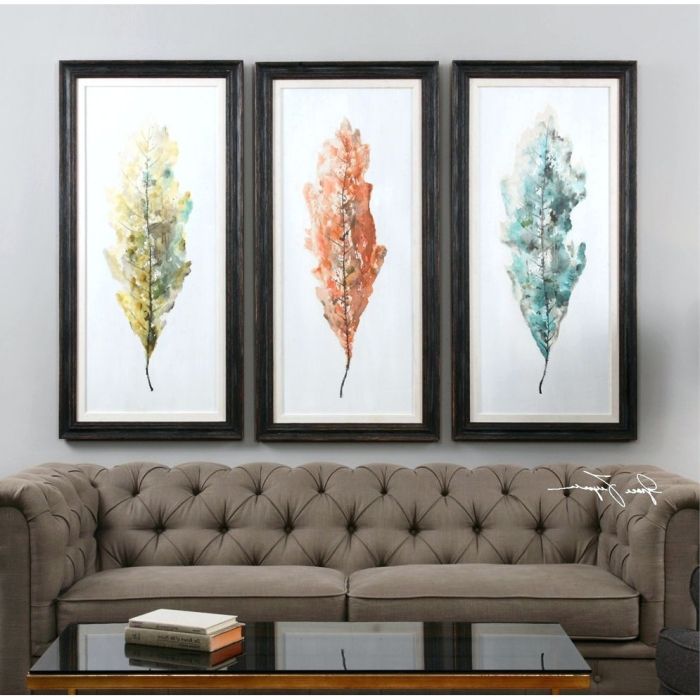Modern Diwali Dinner Table Decor

Diwali dinner table decor – Diwali, the festival of lights, offers a vibrant canvas for creative table settings. Moving beyond traditional décor, modern interpretations embrace sleek lines, minimalist aesthetics, and unexpected color palettes while retaining the celebratory spirit of the occasion. This allows for a sophisticated and stylish Diwali dinner experience that reflects contemporary tastes.Modern interpretations of Diwali table decorations blend traditional elements with contemporary design principles.
Instead of overwhelming the table with intricate patterns and bright, clashing colors, a modern approach prioritizes clean lines and a curated selection of décor. Subtle nods to tradition, such as the use of diyas (oil lamps) or rangoli patterns in a simplified form, can be elegantly integrated into a minimalist setting. The overall effect is one of refined elegance rather than exuberant festivity.
Metallic Accents in Modern Diwali Decor
Metallic accents, particularly gold, silver, and copper, add a touch of opulence and sophistication to a modern Diwali table setting. Gold, often associated with prosperity and good fortune, can be subtly incorporated through chargers, cutlery, or candle holders. Silver provides a cool contrast, perhaps in the form of sleek serving dishes or decorative elements. Copper, with its warm tones, adds a touch of rustic charm.
These metallics can be mixed and matched, creating a layered and visually interesting table setting. For instance, gold chargers could be paired with copper cutlery and silver candle holders, creating a harmonious blend of metallics that enhances the overall aesthetic. The key is to avoid overwhelming the table with too much metallic shine; instead, use them as carefully chosen accents to elevate the design.
Modern Diwali Place Card Designs
Modern place card designs for a Diwali dinner should reflect the overall aesthetic of the table setting. Instead of ornate cards, consider minimalist designs featuring elegant typography and subtle Diwali-inspired motifs. For example, a simple card with a single, stylized diya or a delicate rangoli pattern printed in a metallic ink would be both sophisticated and festive. Alternatively, small, intricately designed metal tags or even pieces of cut-out paper with metallic accents could serve as unique and visually appealing place cards.
The choice of font and color should complement the table’s color palette, creating a cohesive and elegant look.
Modern Diwali Centerpiece Design
A modern Diwali centerpiece should be visually striking yet understated. A simple yet impactful centerpiece could consist of a low, rectangular arrangement of white or cream-colored flowers, such as calla lilies or orchids, interspersed with flickering LED diyas. The use of LED diyas eliminates the risk of fire hazards and provides a safe and elegant alternative to traditional oil lamps.
A mirrored base beneath the arrangement would reflect the light, creating a visually captivating effect. The flowers’ clean lines and minimalist aesthetic would provide a sophisticated backdrop to the warm glow of the LED diyas, creating a harmonious blend of modern and traditional elements. The centerpiece’s low profile ensures that guests have clear sightlines across the table, fostering conversation and interaction.
Color Schemes for Diwali Dinner Table Decor

Diwali, the festival of lights, calls for vibrant and auspicious table settings that reflect the joyous spirit of the occasion. The careful selection of a color palette plays a crucial role in achieving this, enhancing the overall aesthetic appeal and symbolic significance of your Diwali dinner. Choosing the right colors can transform a simple meal into a truly memorable celebration.Color palettes for Diwali table decor should evoke feelings of warmth, prosperity, and good fortune, aligning with the traditional symbolism associated with the festival.
The interplay of warm and cool tones can significantly impact the mood and atmosphere, creating a balance that is both festive and inviting.
Three Diwali Color Palettes and Their Symbolism
Three distinct color palettes effectively capture the essence of Diwali: a traditional warm palette of oranges, yellows, and reds; a sophisticated palette of gold, ivory, and deep maroon; and a more contemporary palette incorporating teal, gold, and fuchsia.The warm palette of oranges, yellows, and reds directly mirrors the vibrant hues of fireworks and diyas, symbolizing energy, happiness, and prosperity. The gold, ivory, and deep maroon palette evokes a sense of richness and elegance, representing luxury and tradition.
Finally, the teal, gold, and fuchsia palette offers a modern twist, retaining the festive spirit while introducing a touch of unexpected vibrancy and sophistication. Each palette offers a unique interpretation of the festival’s spirit.
Warm versus Cool Colors in Diwali Table Settings
Warm colors, such as oranges, reds, and yellows, dominate traditional Diwali celebrations. They represent warmth, energy, and the festive spirit, creating a lively and inviting atmosphere. These colors are associated with fire, light, and the triumph of good over evil. Cool colors, while less traditionally used, can offer a sophisticated contrast. A judicious use of cool tones, such as deep blues or greens, can provide a sense of calm and balance, preventing the setting from becoming overwhelming.
Diwali dinner table decor often features vibrant colors and intricate patterns, reflecting the festival’s joyous spirit. The principles of thoughtful arrangement and creating a visually appealing centerpiece, however, translate across diverse festive occasions. For instance, consider the elegant simplicity often found in table decor for christmas dinner , which, while employing different color palettes, shares the same goal of enhancing the dining experience.
Ultimately, successful Diwali table decor, like its Christmas counterpart, hinges on a harmonious blend of aesthetics and functionality.
The key is to use cool colors sparingly as accents, allowing the warm hues to remain the dominant feature.
Visual Description of a Diwali Table Setting
Imagine a table set with a vibrant orange tablecloth. Golden charger plates provide a luxurious base for ivory dinner plates. Oranges, yellows, and reds are echoed in the floral arrangements: marigolds, roses, and gerberas in various shades create a breathtaking centerpiece. Candles in amber glass holders cast a warm glow, enhancing the overall festive ambiance. The use of metallic accents, such as gold cutlery and napkin rings, further amplifies the feeling of opulence and celebration.
The overall effect is one of joyous energy and festive warmth.
Traditionally Associated Diwali Flowers and Their Significance
Flowers are an integral part of Diwali decorations, adding to the visual splendor and carrying symbolic weight.
- Marigolds (Orange and Yellow): These are ubiquitous during Diwali, representing auspiciousness, prosperity, and warmth. Their bright colors add to the festive atmosphere.
- Roses (Red, Pink, White): Roses symbolize love, devotion, and purity. Red roses, in particular, are associated with passion and celebration.
- Jasmine (White): These fragrant flowers represent purity, spirituality, and grace, adding a touch of elegance to the décor.
- Lotus (Pink, White): The lotus flower is a sacred symbol in many cultures, representing purity, enlightenment, and rebirth, making it an appropriate choice for Diwali.
Lighting and Ambiance for a Diwali Dinner

Crafting the perfect Diwali dinner ambiance hinges significantly on thoughtful lighting. The interplay of candlelight, lantern glows, and the warm shimmer of string lights transforms a simple meal into a truly celebratory experience, reflecting the festival’s spirit of light conquering darkness. A well-designed lighting plan is key to achieving this magical atmosphere.
Different lighting styles profoundly impact the overall mood. Soft, warm lighting evokes feelings of intimacy and togetherness, ideal for a family gathering. Brighter, more focused lighting can create a sense of vibrancy and festivity, perfect for a larger celebration. The strategic use of various light sources allows for a layered and dynamic atmosphere, catering to the diverse needs and preferences of your guests.
A balanced approach, combining the warmth of traditional elements with the modern elegance of contemporary lighting, is often the most effective.
Diya Placement and Symbolic Significance
Diyas, traditional oil lamps, are not merely decorative elements; they hold deep symbolic meaning within Diwali celebrations. Representing the triumph of good over evil, light over darkness, and knowledge over ignorance, they are integral to the festival’s spiritual core. Their soft, flickering light creates a sense of calm and reverence, adding a layer of spiritual depth to the celebratory atmosphere.
Strategically placing diyas around the dining area, perhaps on the table itself (using heat-resistant surfaces), or along windowsills and shelves, enhances both the aesthetic appeal and the symbolic significance of the occasion. Consider using diyas of varying sizes and colors for a visually captivating display. The gentle, warm glow of the diyas complements other light sources, creating a harmonious and evocative ambiance.
Designing a Layered Lighting Plan
A successful Diwali dinner lighting plan involves layering different light sources to create depth and visual interest. Imagine a centerpiece featuring a cluster of intricately carved lanterns, their soft light illuminating the table setting. These could be complemented by strategically placed candles, perhaps in elegant holders or floating in shallow bowls of water with flower petals. String lights, draped subtly above the table or along the walls, add a touch of sparkle and festivity without being overpowering.
The warm glow of these combined light sources would create a welcoming and celebratory atmosphere. Remember to incorporate diyas, perhaps nestled amongst the lanterns or placed along the edges of the table, adding both symbolic meaning and a touch of traditional charm. The interplay of light and shadow, created by the different light sources, adds to the overall visual appeal and creates a magical ambiance.
Creating a Warm and Inviting Atmosphere, Diwali dinner table decor
Achieving a warm and inviting atmosphere for a Diwali dinner requires careful consideration of the lighting’s color temperature and intensity. Warm-toned lighting, with a color temperature around 2700K, is ideal for creating a cozy and intimate setting. Avoid harsh, bright white light, which can feel cold and sterile. Instead, opt for softer, amber-hued lights that mimic the glow of candles and diyas.
Consider using dimmer switches to control the intensity of the lighting, allowing you to adjust the ambiance throughout the evening. The use of natural elements, such as flowers and leaves, combined with the warm glow of the lighting, can further enhance the feeling of warmth and welcome. For example, incorporating garlands of marigolds and jasmine around the dining area, illuminated by the soft glow of candles and diyas, can create a truly enchanting and inviting space.
Key Questions Answered
What are some eco-friendly Diwali table decor options?
Use natural elements like leaves, flowers, and fruits; opt for reusable tableware instead of disposables; choose LED or battery-operated candles for safer and more sustainable lighting.
How can I incorporate family heirlooms into my Diwali table setting?
Incorporate antique tableware, silverware, or even family photographs as place cards. These personal touches add a layer of warmth and sentimental value to your Diwali celebration.
What if I have limited space for a Diwali dinner table?
Focus on a smaller, more intimate setting. Utilize vertical space with hanging lanterns or string lights. Choose a compact centerpiece and prioritize quality over quantity in your decorations.
How do I choose the right tablecloth for my Diwali table?
Consider the overall color scheme and style of your decor. A rich, textured fabric complements traditional settings, while a sleek, modern fabric suits contemporary designs. Choose a fabric that’s easy to clean and durable.


